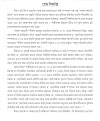Jayanta Dutta
A new report from the Global Commission on the Economics of Water warns that more than half of the world’s food production is at risk due to an escalating water crisis. If left unchecked, this could lead to an average eight percent drop in GDP in many countries by 2050, while low-income nations could suffer losses of up to fifteen percent. The findings highlight that decades of destructive land use, poor water management, and the human-induced climate crisis have placed immense strain on the global water cycle, a development that could have serious repercussions for India’s economy, food security, and people’s lives. Nearly three billion people are already living with water scarcity. On one hand, crops in vast agricultural regions are drying up due to a lack of water, while on the other, many cities are being submerged by floods. Experts stress that this worsening crisis can only be managed through a balanced approach to water use and by recognising the immense value of this finite resource. Understanding the water cycle is essential in this context. It is generally classified into blue water, which is stored in rivers, lakes, and ponds, and green water, which is found in soil and plants. The water cycle is a complex natural process in which water evaporates into the atmosphere, condenses into clouds, and returns to the earth as rain or snow. Green water, often overlooked, plays a critical role in maintaining this cycle because the moisture released by plants returns about half of the planet’s total rainfall to the atmosphere. Unfortunately, the capacity of plants and trees to filter pollutants is steadily declining, further destabilising the cycle. If the water cycle suffers further damage, its consequences will be particularly severe for India. Reduced rainfall and disrupted irrigation patterns will not only affect food production but also limit the availability of drinking water. Some government policies have unintentionally worsened the problem. For example, the subsidy provided on di-ammonium phosphate (DAP) fertiliser may appear beneficial to farmers in the short term, but in reality it is harming soil health and increasing water use. Agricultural scientists have long warned that excessive nitrogen application depletes soil fertility, forcing water-intensive crops such as paddy, wheat, cotton, and sugarcane to consume even more water. Farmers are encouraged to grow coarse grains, pulses, and oilseeds and to use balanced NPK fertilisers, but because these fertilisers are expensive and receive little to no subsidy, they are rarely adopted. The government spends more than two lakh crore rupees annually on subsidising urea and DAP, which encourages the cultivation of surplus paddy and wheat that are then exported in large quantities.
This practice results in what is known as “virtual water export”—the indirect export of water embedded in crops and goods. Producing one tonne of grain requires around a thousand tonnes of water, and India also sends abroad vast amounts of water-intensive products such as sugar, textiles, footwear, fruits, and vegetables. Multinational companies bottling water in India and exporting it to other countries, including water-scarce Arab nations, further contribute to the depletion of domestic resources. Without regulation, this drain on water will worsen the crisis. Water underpins nearly three-fourths of India’s domestic jobs and has a higher economic value than oil or iron, contributing around twenty thousand dollars per hectare globally to maintain ecological balance. Yet, unsustainable agricultural practices, export-oriented cropping patterns, and inefficient irrigation methods are depleting both surface and groundwater reserves at an alarming rate. Of the 1.4 billion cubic kilometres of water on Earth, only two percent is fresh, and seventy percent of that is used for agriculture. About a quarter of the produce grown with this water is exported globally, amounting to the indirect trade of over a thousand billion square metres of water annually. India alone exports nearly ten billion cubic metres of water in the form of crops each year, making it the world leader in virtual water trade. The challenge now is to rethink agricultural policy, adopt modern irrigation methods, and safeguard both blue and green water resources to maintain the natural balance of the water cycle. Without such a shift, the intertwined crises of water scarcity, food insecurity, and economic instability will only deepen, placing India at the epicentre of a global challenge that will define the decades ahead.




















0 Comments